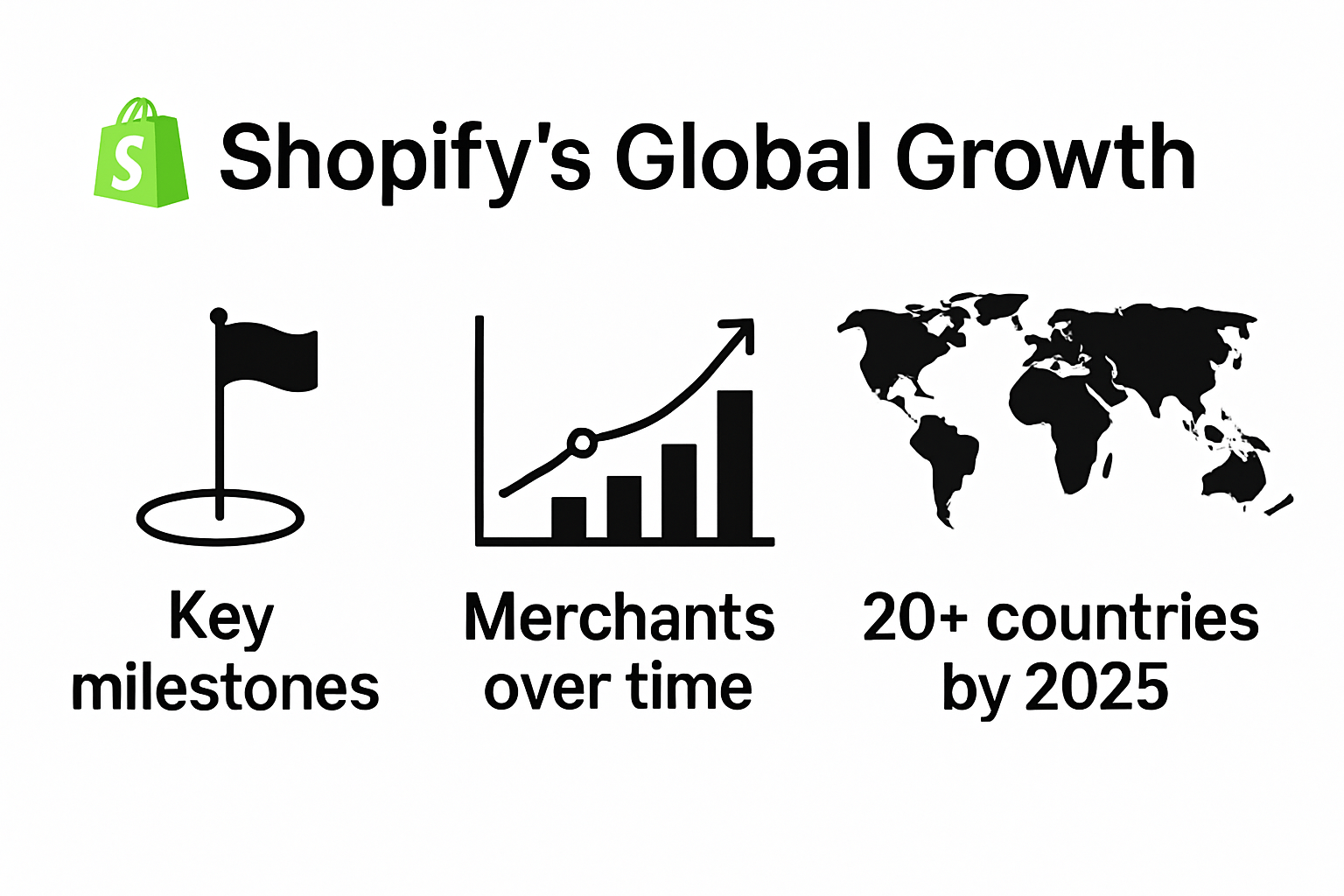Shopify Company Guide 2025: Success for Business Owners

Shopify is now powering more than 1.7 million merchants across 175 countries, giving small shops and massive brands the tools to launch global businesses in days. Most people think building an online store means tech headaches, endless coding, or expensive developers. Shopify flips the script by making ecommerce simpler than ordering a pizza online, and what really shocks new owners is just how much the right features and strategies can unlock growth they never thought possible.
Quick Summary
| Takeaway | Explanation |
|---|---|
| Comprehensive Suite of Features | Shopify provides advanced multichannel selling capabilities, AI-powered tools, and scalable infrastructure, empowering businesses to effectively manage and grow their online operations. |
| Localized Strategies for Market Success | Entrepreneurs should adapt their approach for different markets, focusing on aspects like product positioning, pricing, and language preferences to resonate with local customers. |
| Importance of Continuous Learning | Leveraging educational resources, such as webinars and community forums, is crucial for entrepreneurs to optimize their Shopify experience and keep up with industry trends. |
| Strategic Plugin Management | Careful selection and management of plugins and integrations are essential to enhance functionality, improve customer experience, and drive conversions without bogging down the platform. |
| Holistic Marketing Approach | Implementing multifaceted marketing strategies, including storytelling and personalized customer journeys, can significantly enhance engagement and conversion rates for Shopify stores. |
Shopify Company Overview and Growth
Shopify represents a transformative platform in the ecommerce ecosystem, empowering entrepreneurs and businesses to establish and scale online stores with unprecedented ease. Founded in 2006 by Tobias Lütke, Daniel Weinand, and Scott Lake in Ottawa, Canada, the company emerged from their own frustration with existing ecommerce solutions while trying to sell snowboarding equipment online.
The Rise of a Global Ecommerce Powerhouse
From its humble beginnings, Shopify has grown into a global technology company that provides essential infrastructure for digital commerce. Research from Statista indicates the platform now supports over 1.7 million merchants across 175 countries, demonstrating remarkable growth and global reach. The company’s success stems from its core mission of making commerce better for everyone by removing technical barriers that traditionally hindered small businesses from establishing online presence.

Innovative Business Model and Strategic Expansion
Shopify’s unique business model focuses on providing comprehensive ecommerce solutions that go beyond simple website building. According to shopify annual report, the company generates revenue through multiple streams: subscription solutions, merchant solutions, and a robust app ecosystem. This diversified approach has enabled consistent financial growth, with the platform processing over $319 billion in gross merchandise volume in 2022.
The company strategically expanded its offerings to include point-of-sale systems, shipping tools, financing options, and advanced analytics. By exploring our guide on Shopify development, businesses can understand how these integrated solutions create a comprehensive ecommerce ecosystem.
Key factors driving Shopify’s success include:
- Accessibility: Enabling entrepreneurs of all sizes to launch online stores
- Flexibility: Supporting multiple sales channels and customization options
- Technology: Continuous platform innovation and merchant-focused tools
Shopify’s growth trajectory reflects the broader digital transformation happening in global commerce. By democratizing ecommerce and providing powerful yet user-friendly tools, the company has positioned itself as a critical enabler of digital entrepreneurship worldwide.
The platform’s commitment to supporting small and medium businesses, combined with its robust technological infrastructure, continues to drive its expansion and influence in the global digital economy.
To help clarify Shopify’s global impact and recent business statistics, here’s a summary table of key Shopify metrics referenced in this section:
| Metric | Value |
|---|---|
| Year Founded | 2006 |
| Founders | Tobias Lütke, Daniel Weinand, Scott Lake |
| Merchants Supported | 1.7 million+ |
| Countries Served | 175 |
| Gross Merchandise Volume (2022) | $319 billion |
| Revenue Streams | Subscription solutions, merchant solutions, app ecosystem |
Key Shopify Features for Growing Businesses
Shopify offers a comprehensive suite of features designed to empower businesses of all sizes to establish, manage, and scale their online operations effectively. By providing robust tools that address critical ecommerce challenges, the platform enables entrepreneurs to focus on growth and customer experience.
Advanced Multichannel Selling Capabilities
One of Shopify’s most powerful features is its seamless multichannel selling infrastructure. According to TechRepublic, merchants can simultaneously list and manage products across major platforms like Amazon, eBay, Facebook, Instagram, TikTok, Google Shopping, Pinterest, and Walmart Marketplace from a single dashboard. This integration eliminates the complexity of managing multiple sales channels, reducing administrative overhead and minimizing the risk of inventory discrepancies.

The platform’s mobile app further enhances flexibility, allowing business owners to manage orders, edit product listings, process payments, and receive real-time sales alerts from anywhere. Our Shopify development guide provides deeper insights into leveraging these multichannel selling strategies.
AI-Powered Business Intelligence
Shopify has introduced groundbreaking AI tools that transform how businesses operate. Research from Reuters highlights the platform’s ‘Shopify Magic’ suite, which automates critical tasks such as generating product descriptions, creating marketing content, and developing personalized discount strategies.
Key AI-driven features include:
- Automated Content Generation: Instant product descriptions and marketing materials
- Intelligent Pricing Recommendations: Dynamic pricing strategies based on market trends
- Predictive Sales Analytics: Advanced forecasting and performance insights
The AI assistant ‘Sidekick’ provides additional support by answering management questions, generating comprehensive reports, and recommending optimization strategies tailored to each unique business context.
To provide a clear overview, here’s a table summarizing the key Shopify features highlighted in this section and their primary benefits to businesses:
| Feature | Description | Main Benefit |
|---|---|---|
| Multichannel Selling | List and manage products on Amazon, eBay, Facebook, Instagram, TikTok, Google Shopping, Pinterest, Walmart, and more | Broader audience reach and simplified channel management |
| AI-Powered Tools (Shopify Magic) | Automated content generation, marketing, and discount strategies | Time savings and improved conversion through automation |
| Predictive Analytics | Advanced forecasting and performance reporting | Informed decision-making and business growth |
| Mobile App | Manage orders, payments, and product listings on the go | Increased flexibility for business owners |
| Scalable Infrastructure | Cloud-based, security features, responsive support, global payments | Supports growth from small startup to large enterprise |
Scalable Infrastructure and Payment Solutions
Shopify’s infrastructure is designed to support businesses through every stage of growth. According to Techradar, the platform offers pricing tiers ranging from $29 to $2,300 per month, accommodating everything from individual entrepreneurs to large enterprise operations. Each tier provides progressively advanced features like enhanced security, SSL encryption, PCI compliance, and 24/7 customer support.
The platform’s integrated payment processing eliminates the need for third-party payment gateways, reducing transaction costs and simplifying financial management. With support for multiple payment methods and currencies, businesses can effortlessly expand their global reach.
By combining sophisticated technology, user-friendly design, and continuous innovation, Shopify empowers businesses to transform digital challenges into opportunities for sustainable growth and success.
How to Start With Shopify in India and the US
Launching an online business through Shopify requires strategic planning and understanding of platform-specific nuances for entrepreneurs in India and the United States. While the core process remains consistent, local market dynamics and regulatory considerations play crucial roles in successful implementation.
Preliminary Setup and Account Creation
According to Coursera’s comprehensive guide, establishing a Shopify store involves several critical initial steps. Entrepreneurs must first select an appropriate Shopify plan that matches their business scale and requirements. The platform offers multiple tiers ranging from basic to advanced, allowing flexibility for businesses at different growth stages.
Key considerations during account setup include:
- Business Registration: Ensuring legal compliance in respective jurisdictions
- Tax Identification: Obtaining necessary tax numbers for India (GST) or US (EIN)
- Payment Gateway Selection: Integrating region-specific payment methods
Our Shopify development experts recommend thoroughly researching local ecommerce regulations before launching your online store.
Localization and Market-Specific Strategies
Successful Shopify stores in India and the US require nuanced approaches to product positioning, pricing, and customer engagement. In India, businesses must consider regional language preferences, diverse payment ecosystems, and price sensitivity. US markets demand sophisticated digital marketing strategies and emphasis on user experience. Research from Statista indicates India’s ecommerce market is projected to reach 467 million users by 2025, presenting significant opportunities for digital entrepreneurs. Conversely, the US market offers advanced technological infrastructure and higher consumer spending potential.
Critical localization strategies include:
- Multilingual website options
- Region-specific shipping configurations
- Culturally relevant product descriptions
- Localized customer support mechanisms
Technical Implementation and Launch
The technical implementation of a Shopify store involves several universal yet nuanced steps. Entrepreneurs must carefully design their online storefront, select appropriate themes, integrate product catalogs, configure payment gateways, and establish robust shipping protocols.
Important technical considerations include:
- Responsive mobile design
- SEO optimization
- Secure payment integrations
- Comprehensive inventory management
- Analytics and performance tracking
Whether launching in Mumbai or Manhattan, successful Shopify stores prioritize user experience, seamless navigation, and clear value propositions. By understanding platform capabilities and local market dynamics, entrepreneurs can create compelling digital storefronts that resonate with their target audiences.
The journey of establishing a Shopify store transcends geographical boundaries, requiring a blend of technological proficiency, market understanding, and strategic vision. Continuous learning, adaptation, and customer-centric approach remain the cornerstone of sustainable ecommerce success.
Tips for Maximizing Success Using Shopify Company
Navigating the Shopify ecosystem requires strategic approaches that go beyond basic platform utilization. Successful entrepreneurs leverage multiple tools, resources, and techniques to transform their online stores into thriving digital businesses.
Leveraging Educational Resources and Learning Platforms
According to Shopify’s Growth Center, merchants have access to comprehensive educational resources designed to accelerate their ecommerce journey. The Shopify Academy, blogs, YouTube tutorials, and Shopify Masters Podcast provide invaluable insights into platform optimization, marketing strategies, and industry trends. Our Shopify development experts recommend entrepreneurs invest time in continuous learning, treating these resources as strategic investments in their business growth. Key learning strategies include:
- Regularly attending webinars and online workshops
- Following successful store case studies
- Participating in Shopify community forums
- Exploring advanced platform features through tutorials
Strategic Shopify Apps and Integration Management
Research from Constant Contact highlights the critical role of apps and integrations in enhancing store functionality. Successful Shopify stores meticulously select and implement tools that streamline operations, improve customer experience, and drive conversions.
Essential integration considerations include:
- Marketing Automation: Email campaign tools
- Customer Support: Live chat and ticketing systems
- Analytics: Advanced tracking and reporting plugins
- Inventory Management: Real-time stock synchronization
Careful plugin selection prevents platform bloat and ensures optimal performance. Business owners should regularly audit their integrations, removing redundant or underperforming tools.
Advanced Marketing and Conversion Optimization
According to SCORE’s small business resources, successful Shopify stores implement multifaceted marketing strategies that extend beyond traditional advertising. Modern entrepreneurs utilize interactive content, high-quality visual storytelling, and data-driven marketing approaches.
Key marketing optimization techniques include:
- Creating engaging product storytelling
- Implementing interactive content like quizzes
- Utilizing high-resolution, professionally shot product images
- Developing personalized customer journey experiences
- Leveraging social media integration and selling channels
Successful Shopify businesses recognize that platform mastery involves continuous experimentation, learning, and adaptation. By embracing a holistic approach that combines technological tools, educational resources, and creative marketing strategies, entrepreneurs can transform their online stores into dynamic, profitable ventures.
The journey of Shopify success is not about perfection but persistent improvement. Each small optimization contributes to building a resilient, customer-centric digital business that can withstand market fluctuations and emerging ecommerce trends.
Frequently Asked Questions
What is Shopify and how does it work?
Shopify is an ecommerce platform that allows businesses to create and manage online stores easily. It provides tools for product listing, payment processing, and multichannel selling, removing technical barriers for entrepreneurs.
How many merchants use Shopify globally?
Shopify powers over 1.7 million merchants across 175 countries, making it a leading platform for businesses of all sizes looking to establish an online presence.
What are the key features of Shopify for online businesses?
Key features include advanced multichannel selling capabilities, AI-powered business intelligence, scalable infrastructure, and integrated payment solutions, all designed to help businesses grow efficiently.
How can I start a Shopify store in India or the US?
To start a Shopify store, select a suitable plan, complete business registration, choose payment gateways, and customize your store according to local market needs. It’s important to consider market-specific strategies for successful implementation.
Ready to Launch or Elevate Your Shopify Store?
Many business owners reach a breaking point with complex store setups, lackluster designs, and underperforming marketing. If you felt overwhelmed reading about multichannel selling and AI-powered tools in the Shopify Company Guide 2025, you are not alone. Most entrepreneurs know their goals—smooth setup, seamless sales channels, and powerful online growth—but struggle with website design or digital marketing that actually converts.

Stop losing momentum and let experienced professionals handle these details for you. Visit Appfinz Website Design and Digital Marketing to:
- Get a custom Shopify store setup that matches your brand vision and localizes for markets like India or the US
- Tap into digital marketing strategies that maximize traffic and conversions
- Ensure everything from responsive design to seamless payment integration is handled from start to finish
Take your next step toward Shopify success. Reach out now on https://appfinz.com so you can turn the knowledge from this guide into real business growth. Opportunities for 2025 are waiting—do not let your Shopify store get left behind.
Recommended
- Top-rated Shopify Development Company in Delhi | Expert Shopify Developers in India
- Ecommerce SEO Services to Boost Online Presence | Ecommerce SEO Agency
- Ecommerce Website Development Company in Delhi, Best Ecommerce Website Designing
- API Development & Integration Services | Custom API Solutions Company
